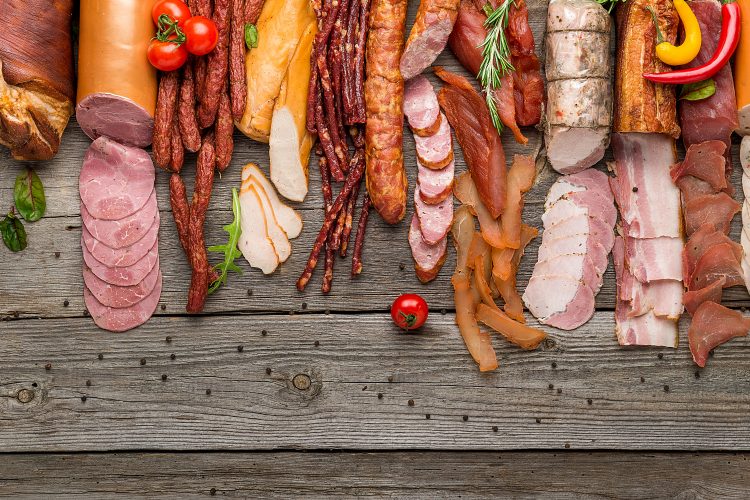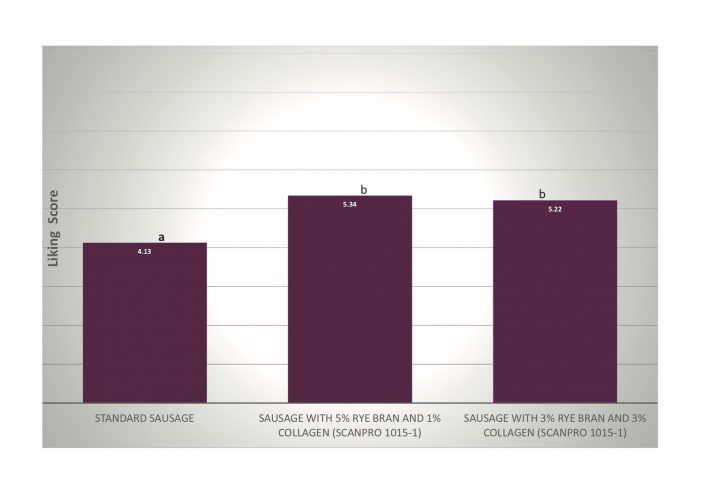Towards healthier meat products
- Like
- Digg
- Del
- Tumblr
- VKontakte
- Buffer
- Love This
- Odnoklassniki
- Meneame
- Blogger
- Amazon
- Yahoo Mail
- Gmail
- AOL
- Newsvine
- HackerNews
- Evernote
- MySpace
- Mail.ru
- Viadeo
- Line
- Comments
- Yummly
- SMS
- Viber
- Telegram
- Subscribe
- Skype
- Facebook Messenger
- Kakao
- LiveJournal
- Yammer
- Edgar
- Fintel
- Mix
- Instapaper
- Copy Link
Posted: 12 February 2019 | Hanne Christine Bertram, Line Ahm Mielby, Line Hjelm, Nina Eggers, Rebekka Thøgersen | No comments yet
Hanne Christine Bertram, Line Hjelm, Rebekka Thøgersen, Nina Eggers and Line Ahm Mielby of the Department of Food Science, Aarhus University, Denmark look at recent innovations in the meat product sector, with particular emphasis on hybridised products and nutri-functionality by metabolomics.


Meat is nutritious and important
Meat is a highly nutritious component of our diet. It provides all the essential amino acids that our bodies need, and the bioavailability and digestibility of meat proteins is strikingly high.3 In addition, meat is a vital source of minerals and vitamins; especially vitamin B12 – something that is often lacking in sufficient amounts within a vegetarian diet.9 But how can meat products become even more attractive from a nutritional perspective? A recent trend in food innovation is the introduction of hybridised products, where animal-derived and plant-derived ingredients merge to form a new hybrid. In many ways, this is an attractive strategy as it combines the best of the animal world with the best of the plant world. A vast amount of evidence supports the notion that intake of dietary fibres originating from plant-based materials possesses multiple health benefits. These can largely be ascribed to the fact that they stimulate a health-promoting metabolic activity of the microbiota harboured in our gut.10 Given this evidence, attempts have been initiated to introduce dietary fibres into meat products. In academia, activities in this area are not new and reports on the introduction of a variety of dietary fibre sources can be found in scientific literature.7
Dietary fibres – mode of action
Dietary fibres constitute carbohydrates that are resistant to the digestive enzymes in the gastrointestinal tract and thus pass unaltered to the large intestine. In the large intestine, these dietary fibres may act as substrates for the gut microbiota. During fermentation of dietary fibres by the gut microbiota, so-called short-chain fatty acids are generated. These include acetic acid, propionic acid and butyric acid.6 There is considerable evidence to suggest that the short-chain fatty acids – in particular, butyric acid –beneficially impact the epithelial cells in the intestine, where they act as energy substrates that promote healthy and well-functioning intestinal cells.12 In addition, research also indicates that butyric acid is a key trigger in the gut-brain axis and is thought to be involved in the regulation of satiety and other essential systemic mechanisms, such as blood-pressure regulation.4 Thus, when probing the beneficial effects of dietary fibres, short- chain fatty acids are key.
Metabolomics for documentation of beneficial effects
Despite several research studies having explored the technological aspects of the addition of dietary fibres to meat products, few studies have actually investigated whether fibre enrichment of a meat product results in a food with enhanced nutri-functionality. Thus, evidence that fibre addition to meat products improves their nutritional value has been lacking. Metabolomics represents a modern and advanced technique for capturing our metabolic signature. Recently, metabolomics has been developed for investigations into how diet influences our endogenous metabolic response, thereby facilitating a more detailed understanding of how diets impact us.2 To shed light on how nutri-functionality of meat products may be enhanced through fibre enrichment, we recently developed a frankfurter-like pork sausage containing six percent inulin (Orafti HP from Beneo-Orafti, Belgium) and compared it with a corresponding control sausage identical in macro-composition. Under a controlled experimental setup, the sausages were fed to healthy rats as their sole diet for a period of four weeks.
Through metabolomics analyses of blood and faecal samples collected from the rats fed the sausages, we examined how the inulin-enriched sausages influenced the profile of metabolites circulating in the blood and excreted in stools.11 Intriguingly, the results showed that the metabolome could differentiate between rats fed the standard sausage and the inulin-enriched sausage, respectively. Rats fed the inulin-enriched sausage had higher levels of short-chain fatty acids such as butyric acid, propionic acid and acetic acid in their stool and blood plasma.11 Thus metabolomics convincingly demonstrated that the health benefits associated with intake of dietary fibres are obtained when those fibres are incorporated into meat products. From this we can conclude that a huge and favourable potential for developing innovative and health-promoting meat products based on fibre-enrichment exists as documented by an advanced metabolomics approach.
Consumer acceptance trumps all
A prerequisite in the launch of new and healthier meat products is that they should be tasty, delicious


Meat is a vital source of minerals and vitamins; especially vitamin B12 – something that is often lacking in sufficient amounts within a vegetarian diet
and meet consumers’ expectations and demands.1 Taste is indisputably a pivotal and decisive parameter that determines how we perceive and assess any food product. The texture of a food product is also integral to our perception of it. We have very clearly defined expectations regarding the texture of food products: chips must be crispy, beef must be tender and juicy, and meat sausages must have the right ‘bite’. Taste and texture are therefore the most challenging attributes in the introduction of new and healthier meat products when ingredients such as fat are reduced or replaced with new ingredients that may have a distinctly different influence on taste and texture. In addition, when plant-derived materials such as dietary fibres are included as ingredients in meat products to create hybrid products, the plant-based materials will often be responsible for a distinctive and undesired contribution to the taste,7 with product texture often being compromised.8
Ingredients facilitate innovative and healthier meat products
Ingredients find use in many food innovations, where they help facilitate desired attributes of food products. Consumers are also increasingly aware as to whether or not ingredients can be categorised as artificial or natural additives. Collagen extracted from skin and hides is a natural ingredient that finds use in the meat industry. Collagen’s keen ability to create strong protein-water interactions makes it a superior ingredient to promote water-binding capacity. In this way collagen ingredients enhance product firmness and promote a desirable texture in sausage products, which is crucial for consumer acceptance. To investigate whether these attractive attributes of collagen could aid in the inclusion of health-promoting dietary-fibre ingredients that may modify product texture, we recently conducted a scientific study where combinations of fibre-rich rye bran (Skærtoft Mølle, Denmark) and collagen were included in Frankfurter pork sausages.5 In this study – carried out in collaboration with Essentia Protein Solutions A/S – a range of Frankfurter sausage recipes with different combinations of rye bran (included in levels between three and six percent w/w) and collagen (Scanpro 1015-1 and Scanpro 1015-3 included in levels between one and three percent w/w) was developed. By including a combination of rye bran and collagen, a 50 percent reduction in fat content was achieved, clearly improving the nutritional profile of the sausages.


Figure 1: Results from a consumer survey (n=32) where three sausages were served; a standard sausage (fat content 25.5% w/w), a sausage containing 5% w/w rye bran and 1% w/w collagen (Scanpro 1015-1) (fat content 12.5%), and a sausage containing 3% w/w rye bran and 3% w/w collagen (Scanpro 1015-1) (fat content 10.7%). The participants were asked to evaluate the sausages on a scale ranging from 0 to 9 according to how much they liked them. Letters a and b in the figure indicate statistical difference (P<0.05).
The technological attributes of the sausage products were examined by various instrumental analyses, such as texture profile analysis and low-field NMR, and the sausage products were also evaluated both blindly and objectively by a trained sensory panel. The results clearly demonstrated that through the addition of collagen, product texture could be modified.5 Furthermore, the collagen ingredients were found not only to impact textural attributes, but their inclusion also strikingly impacted taste attributes of the sausages,5 probably because the natural collagen ingredients originating from pork skin also provide important meat-like flavour precursors to the sausage product. Consequently, through the addition of collagen, the overall acceptance of rye-bran-enriched sausages was improved. A small consumer survey (n=32) confirmed that the combination of rye bran and collagen inclusion represents a favourable sausage product solution, as the study showed that consumers preferred sausages containing either five percent rye bran/one percent collagen or three percent rye bran/three percent collagen as compared with the standard sausage (Figure 1).
Conclusions
Ingredients can aid the development of healthier meat products by providing active ingredients such as dietary fibres that improve the nutritional profile of the products and by providing functionality that facilitates attractive product attributes that meet consumers’ expectations. With increasing consumer awareness and interest in healthy food choices, it is anticipated that hybridised products, where attractive plant-based components are integrated into more traditional meat products, will dominate future innovation in the meat industry. Ingredients have emerged as a successful and key element in food innovations and they are predicted to play an important role in the development of new hybridised products where ‘healthiness’ is a key driver. Any ingredients, however, must meet and fulfill consumers’ perception of ‘natural’ and their preference for so-called ‘clean label’.
About the authors








Nina Eggers is a laboratory technician at Aarhus University, Department of Food Science. Ms. Eggers has some 25 years of experience in food research and works intensively within sensory science, training sensory panellists and carrying out descriptive sensory analyses.


References
- Arvola A, Lähteenmäki L, Tuorila H. 1999. Predicting the intent to purchase unfamiliar and familiar cheeses: The effects of attitudes, expected liking and food neophobia. Appetite, 32, 113–126.
- Bertram HC, Jakobsen LMA. 2018. Nutrimetabolomics – integrating metabolomics in nutrition to disentangle intake of animal-based foods. Metabolomics, 14: 34. Doi: 10.1007/s11306-018-1322-3.
- Burd NA, Gorissen SH, van Vliet S, Snijders T, van Loon LJC. 2015. Differences in postprandial protein handling after beef compared with milk ingestion during postexercise recovery: a randomized controlled trial. American Journal of Clinical Nutrition, 102, 828–836.
- Byrne CS, Chambers ES, Morrison DJ, Frost G. 2015. The role of short chain fatty acids in appetite regulation and energy homeostasis. International Journal of Obesity, 39, 1331-1338.
- Hjelm L, Mielby LA, Gregersen S, Eggers N, Bertram HC. 2018. Partial substitution of fat with rye bran fiber in Frankfurter sausages – bridging technological and sensory attributes through inclusion of collagenous protein. LWT Food Science & Technology. In press.
- Lamichhane S, Yde CC, Jensen HM, Morovic W, Hibberd AA, Ouwehand AC, Saarinen MT, Forssten SD, Wiebe L, Marcussen J, Bertelsen K, Meier S, Young JF, Bertram HC. 2018. Metabolic fate of 13C-labelled polydextrose and impact on the gut microbiome: A triple-phase study in a colon simulator, J. Proteome Res. 17, 1041-1053.
- Mehta N, Ahlawat SS, Sharma DP, Dabur RS. 2015. Novel trends in development of dietary fiber rich meat products-a critical review. Journal of Food Science Technology, 52, 633–647.
- Petersson P, Godard O, Eliasson AC, Tornberg E. 2014. The effects of cereal additives in low-fat sausages and meatballs. Part 2: Rye bran, oat bran and barley fibre. Meat Science, 96, 503-508.
- Petti A, Palmieri B, Vadala M, Laurino C. 2017. Vegetarianism and veganism: not only benefits but also gaps. A review. Progress in Nutrition, 19, 229-242.
- Slavin J. Fiber and prebiotics: mechanisms and health benefit. 2013. Nutrients, 5, 1417-1435.
- Thøgersen R, Castro-Mejía JL, Sundekilde UK, Hansen LH, Hansen AK, Nielsen DS, Bertram HC. 2018. Ingestion of an inulin-enriched pork sausage product positively modulates the gut microbiome and metabolome of healthy rats. Molecular Nutrition & Food Research, 62(19):e1800608.
- Topping DL, Clifton PM. 2001. Short-chain fatty acids and human colonic function: roles of resistant starch and nonstarch polysaccharides. Physiological reviews. 81, 1031-1064.
Issue
Related topics
Health & Nutrition, Ingredients, New product development (NPD), Product Development, Research & development, Technology & Innovation, The consumer
Related organisations
Beneo-Orafti, Essentia Protein Solutions A/S, Skærtoft Mølle







